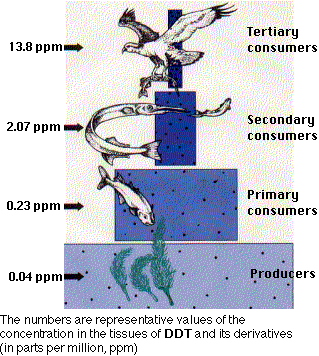How do trophic levels affect bioaccumulation?
1 Answer
Biomagnification is definitely dependent on the number of trophic levels but bioaccumulation happens to all organisms regardless of the trophic level the organism is in.
Explanation:
Bioaccumulation occurs within one organism whereas biomagnification occurs across multiple trophic levels. Thus, the answer to the question is going to depend on which term you're thinking about.
Bioaccumulation for a polar bear (a carnivore) would result if the polar bear consumes multiple seals that have a pollutant. The pollutant would build up in the polar bear the more seals the animal consumed. The same is true for a herbivore. If a giraffe consumes multiples leaves that have been sprayed with a pollutant, the more leaves the giraffe consumes, the more of the pollutant will build up in the giraffe.
The amount of biomagnification that occurs is going to depend in part on how many trophic levels are involved.
For example let's say we have mercury (Hg) that enters the ecosystem. Mercury bioaccumulates, so if an aquatic plant absorbs some mercury because it's in the soil, it's going to have a higher concentration of mercury than the soil in the ecosystem. This is because there is far more soil in the ecosystem, and the mercury will be spread out throughout that soil.
So a tiny amount of mercury in the soil is going to be the same quantitative amount when it is absorbed by the aquatic plant, but because the aquatic plant is smaller than the soil, that same quantitative amount is going to have a greater impact on the plant than it did on the soil. The concentration is higher.
For pollutants to biomagnify or bioaccumulate, they have to stick around for a long period of time. If they degrade in a few hours, there will be no biomagnification or bioaccumulation.
Here's an example of biomagnification, where the pollutant (DDT) becomes more concentrated as we move up trophic levels:


